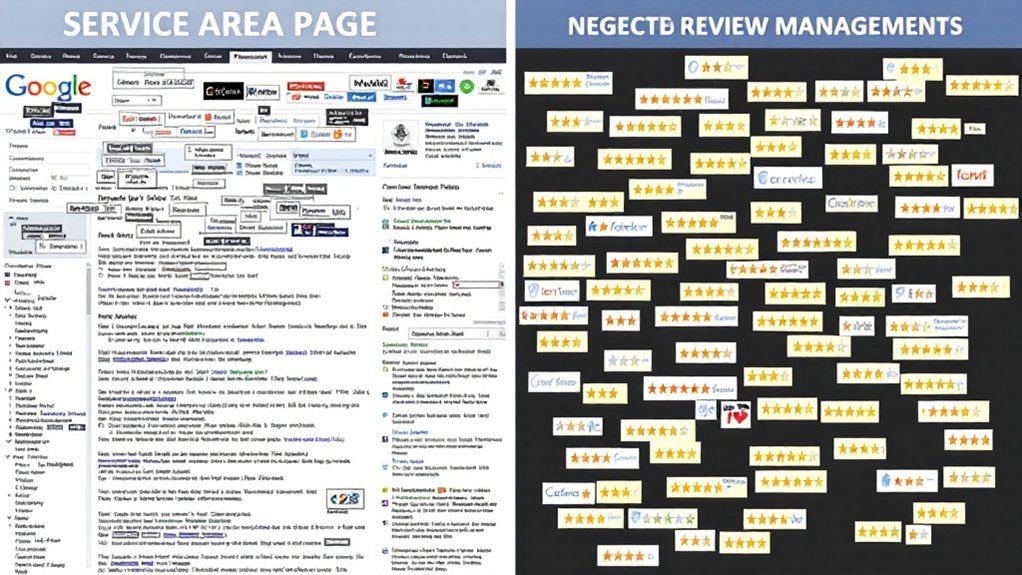To avoid common mistakes in service area page SEO, ensure your business name, address, and phone number (NAP) are consistent across the web. Complete your Google Business Profile with accurate information, and actively manage online reviews to build trust. Generate local backlinks and maintain an active social media presence to boost visibility. By addressing these key areas, you'll lay the foundation for successful local SEO and attract more customers to your business.
Inaccurate NAP Inconsistencies

Although consistent NAP (Name, Address, Phone number) information is crucial for local SEO, many businesses struggle with inaccurate NAP inconsistencies across their digital presence. Variations in business name spelling, address formatting, and phone number discrepancies can lead to lower local search rankings as search engines doubt the credibility of the business. This not only impacts your visibility but also erodes customer trust and results in missed sales opportunities. Consistent NAP information across citations builds trust with search engines and customers. To avoid these pitfalls, standardize your NAP format, conduct regular audits, and utilize tools to manage and track citations. Integrating schema markup can further enhance search engine understanding of your NAP details, ensuring a consistent and trustworthy digital presence.
Incomplete Google Business Profile Listings

Many businesses struggle with incomplete Google Business Profile listings, unaware of the significant consequences it can have on their local visibility and customer engagement. Incomplete profiles are 7x less likely to engage customers, and nearly 50% of profiles contain incorrect or missing information, harming business visibility. This leads to missed opportunities for revenue and customer trust. Conversely, complete profiles enhance credibility, increase interactions, and improve local search rankings. To optimize your profile, fill out all required fields, add high-quality photos, and engage with customers through reviews and messages. Regular profile updates ensure accuracy and maximum online reach. Investing time in profile completeness is crucial for local SEO success. [The profile strength label is a new feature that aims to encourage more engagement with Google Business Profiles.
Lack of Comprehensive Review Management

Neglecting to monitor and respond to reviews can hurt your local SEO. Failing to actively generate new reviews also undermines your online reputation. Improving your review management is crucial for boosting your service area page's visibility and credibility. Reviews are a key local ranking factor, accounting for about 15.44% of local SEO ranking factors.
Neglected Review Monitoring
Failing to monitor customer reviews can severely erode trust in your brand, as poor management reflects negatively on your business's reputation. Neglecting reviews means missing opportunities to engage with customers and build a loyal community. This can lead to decreased visibility in search results due to lower user engagement. Without a feedback loop, you'll struggle to identify service areas for improvement. Competitors can gain an upper hand by leveraging review management to boost their local SEO rankings. Utilize review tracking tools, analyze metrics regularly, and respond promptly to both positive and negative feedback. Effective review management strengthens your local credibility and trust, giving you a competitive edge.
Ineffective Review Generation
While reviews significantly impact a business's local SEO rankings, you may find your review generation efforts are lacking in comprehensiveness. Overreliance on a single platform, lack of dedicated review campaigns, and underutilized customer touchpoints can all contribute to an inconsistent review flow and an incomplete view of customer satisfaction.
| Shortcomings | Consequences |
|---|---|
| Dependence on Singular Platforms | Missed opportunities from other review platforms |
| Lack of Dedicated Campaigns | Limited review diversity |
| Underutilized Touchpoints | Missed review generation opportunities |
| Inconsistent Review Flow | Fluctuations in perceived business performance |
| Review Universality | Incomplete understanding of customer satisfaction |
Addressing these gaps in your review generation strategy is crucial for maintaining a strong online reputation and maximizing the impact of reviews on your local SEO.
Poor Response Management
Effective review response management is crucial for maintaining a positive online reputation and reinforcing customer trust. Avoid inconsistent respondence, generic responses, and delayed reactions, which can convey disinterest in customer feedback. Provide context-rich, personalized responses that address specific concerns and praise. Promptly address negative reviews to mitigate their impact on your SEO. Showcase local testimonials, utilize visual content, and incorporate case studies to make your review responses more engaging. Ensure your tone is consistent with your brand voice and reflects empathy for your customers' needs. Continuously monitor review metrics and update content to foster a sustainable feedback loop with your audience. Leveraging local reviews can boost Local SEO efforts by demonstrating commitment to each community.
Insufficient Local Backlink Generation
Although local backlinks significantly impact a service area business's local SEO rankings, you may be struggling to generate a sufficient number of them. Failing to build local backlinks can lead to poor visibility and credibility issues. Over 800 million monthly U.S. searches include "near me", underscoring the necessity of local SEO. Localized SERP content is critical for ranking in local search, and local link building improves rankings and credibility within the community. To address this, you should:
- Optimize local directories to generate quality backlinks
- Engage with local media for coverage and backlinks
- Create linkable content relevant to the local community
- Collaborate with other local businesses for mutual benefit
- Utilize Google Business Profile to enhance visibility and attract links
Addressing insufficient local backlink generation is crucial for service area businesses to thrive in local search.
Inconsistent Social Media Presence Maintenance
Maintaining a consistent social media presence is crucial for service area businesses seeking to enhance their online visibility and credibility. Neglecting inactive or abandoned social media accounts can signal a lack of relevance, while inconsistent branding across platforms can confuse potential customers. Strong social media presence helps build brand awareness and trust. Failing to monitor social media for negative feedback can damage your brand's reputation and impact your SEO performance. Regularly updating profiles with fresh, relevant content is key to maintaining online visibility and improving SEO. Engaging with your audience, optimizing content for mobile, and leveraging social media analytics are essential strategies for driving meaningful engagement and boosting your SEO efforts.
Neglecting Semantic Search Optimization
Why are service area businesses neglecting semantic search optimization? Perhaps it's the mistaken belief that keyword-focused strategies are enough. But the reality is, neglecting semantic search optimization leaves you missing out on enhanced visibility, user experience, and ranking potential.
- Failure to leverage structured data like Schema.org inhibits search engines from fully understanding your services.
- Ignoring HTML5 semantics makes it harder for users and crawlers to navigate your site.
- Generic, context-lacking content struggles to align with searchers' natural language.
- Not incorporating LSI keywords means missed opportunities to demonstrate your relevance.
- A keyword-centric approach disregards how modern search engines interpret user queries.
Embrace semantic search optimization – it's key to ensuring your service area pages connect with the right customers at the right time.
Improper Utilization of Header Tags
Proper header tag structure is crucial for effective service area page SEO. Neglecting to organize your content with a clear hierarchy using H1, H2, and H3 tags can confuse both users and search engines. Misaligning your header tags with the actual content and target keywords will undermine your page's relevance and visibility. Incorporating relevant secondary keywords in your header tags can further enhance the topical relevance of your service area pages.
Improper Hierarchy Structure
Improper header tag utilization can quickly derail a service area page's SEO performance. A disorganized hierarchy structure confuses search engines, making it difficult to determine the main content focus. Inconsistent or incorrect use of header tags, such as randomly switching between H2 and H3, can lead to SEO issues and a poor user experience.
- Overusing headers or using them for decorative purposes can make your content appear cluttered and less appealing.
- Failing to include relevant keywords in headers reduces the page's relevance to target search terms.
- A poorly structured page with disorganized headers can decrease crawlability, affecting your overall SEO.
- Weak content structure can cause your page to miss out on ranking opportunities.
- Properly structured content helps provide a better user experience, potentially increasing engagement and conversion rates.
Lack of Semantic Meaning
While header tags are crucial for structuring your content, their improper utilization can significantly undermine your service area page's SEO performance. Failing to use semantic markups leaves search engines struggling to understand the context and relevance of your content. This, in turn, can negatively impact your rankings and visibility. Ensure your header tags align with the information hierarchy, providing a clear and logical structure. Leverage the semantic meaning of these tags to convey the purpose of each section, enhancing both user experience and search engine comprehension. Proper header tag usage is essential for an effective SEO strategy, so don't overlook this critical aspect of your service area page optimization.
Failure to Prioritize Mobile Optimization
If you fail to prioritize mobile optimization for your service area pages, you risk missing out on a significant portion of your target audience. Over 58.67% of website traffic comes from mobile devices, and Google prioritizes mobile-friendly sites in local search results. Neglecting mobile optimization can lead to higher bounce rates, lower engagement, and a competitive disadvantage in your industry.
- Responsive design ensures consistency across devices, essential for mobile searching.
- Page speed optimization is crucial for reducing load times and improving user experience on mobile.
- Simplified forms and intuitive navigation are critical for boosting conversion rates on mobile.
- Local SEO integration, such as accurate Google My Business listings, is vital for reaching mobile users.
- Failure to optimize for mobile can severely limit the visibility and effectiveness of your service area pages.
Incorrect or Missing Schema Markup Implementation
Improper schema markup implementation can seriously hinder your service area page's visibility and performance. You need to ensure you're using the right schema properties, types, and placement to accurately represent your business and service areas. Failure to regularly maintain and update your schema as your business evolves can further exacerbate these issues.
Incorrect Schema Syntax
Accurately implementing schema markup is crucial for effectively communicating your service area information to search engines. However, improper syntax can undermine your efforts, leading to inaccurate or confusing results. Avoid these common mistakes:
- Misusing the 'areaServed' property by providing vague or irrelevant locations.
- Listing numerous cities instead of using the more efficient county-level designation.
- Failing to clarify service areas when using both counties and cities.
- Providing misleading service area statements that can confuse search engines.
- Neglecting to regularly validate your schema markup to ensure accuracy.
Maintaining consistent, accurate, and well-structured schema markup is essential for improving your service area page's SEO performance and delivering a positive user experience in search results.
Incomplete Business Details
Incomplete or missing schema markup can undermine your ability to effectively communicate key business details to search engines. Without consistent NAP (name, address, phone number) data, you risk negatively impacting your local SEO rankings. Failing to include essential information like logos, social media profiles, or contact numbers can limit your search visibility. Incomplete schema can also omit crucial details about your business hours, locations, or services offered, hindering the creation of knowledge panels and other informative features. This is especially detrimental for local businesses, as missing schema details can impact your visibility in location-specific searches and Google's local pack results. Addressing these gaps in your schema implementation is crucial for boosting your SEO performance and user engagement.
Overlooking Site Speed Optimization
While site speed may not be the first factor that comes to mind when optimizing service area pages, it's a critical element that you can't afford to overlook. Fast loading times directly impact user experience, bounce rates, and conversion rates. Ignoring performance bottlenecks like slow database queries and inefficient hosting can seriously hinder your site's speed. Remember to:
- Prioritize mobile-friendly design and optimization
- Minimize HTTP requests by using a CDN
- Regularly monitor site performance for bottlenecks
- Implement techniques like content and image compression
- Ensure your hosting plan can handle your site's traffic
Optimizing site speed is a key SEO strategy that search engines consider. Don't let slow load times undermine your service area page performance.
